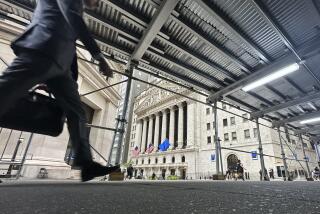Homes for export; assembly required
In a dusty field on the outskirts of China’s capital, Fan Zhi has built the American dream. The two-bedroom cottage comes with a front porch. The rocking chair is not included.
By capturing the attention of Americans weary of high heating bills and soaring construction costs, Fan hopes to turn this prefab home into the McBungalow of the home-building world. He says his energy-efficient product, which can be assembled in less than three hours, can withstand hurricane-strength winds and Southern California wildfires.
Fan shouldn’t have to go overseas to seek his fortune. Burdened with some of the world’s most polluted cities and a skyrocketing bill for imported fuel, the Chinese government has launched a multibillion-dollar energy-conservation campaign that includes tough restrictions for new construction.
But last week, Qiu Baoxing, the vice minister of construction, acknowledged that the government’s efforts were failing because local officials weren’t enforcing the laws. A survey by the Construction Ministry found that only 53% of new buildings were in compliance with the new energy-efficiency regulations, according to the local media.
Qiu ordered developers to reduce energy consumption for heating, lighting and air conditioning in all new buildings by 50% or they would risk losing their business licenses.
Fan, the founder of Beijing Taikong Panel Industry Corp., isn’t optimistic that the government will win this battle. He estimated that it would be at least five to 10 years before there was a large market in China for his product, which costs about 20% more than those using traditional building materials. Since launching his home division last year, he has sold only a couple dozen units.
“Look at all those homes,” he said, pointing to a skyline filled with high-rise buildings and construction cranes. “If you moved them to the United States or Britain, none of them would meet energy-efficiency standards.”
That’s why Fan is looking to America, where rising energy costs and growing environmental awareness have spurred interest in eco-friendly architecture. Employment costs also are high, increasing the attractiveness of prefabricated homes, which can be built quickly using minimal labor.
“Our major aim is to build a few world-class brands, just like BMW or Mercedes-Benz,” said Fan, who has been playing host to a steady stream of foreign visitors since the state-run China Daily published an article about his company several weeks ago.
During a recent visit by a delegation from Mississippi and Florida, a crew of nine blue-jacketed workers at Fan’s factory built a 680-square-foot home in less than three hours. A giant crane was used to swing the steel-framed panels into place, which were then bolted onto a concrete foundation. That home, sold for $31,500 to a Chinese buyer, will be dismantled and rebuilt in another part of Beijing.
Fan faces huge hurdles, including securing foreign government approvals for his unusual product. In the U.S., for example, homes must adhere to dozens of federal, state and local building codes.
Fan’s homes are produced using a patented technology that layers foam cement and fiberglass netting to create a strong but relatively lightweight material.
Fan started out in commercial construction in 1993, but shrinking profit prompted him to move into home building last year. Residential real estate prices in China are exploding in spite of the government’s efforts to slow the market by raising property taxes, placing restrictions on foreign home buyers and other measures. The average price of a single-family home in the capital last year topped $600,000, according to Beijing news reports.
Fan’s finished homes aren’t the cheapest on the market, selling for $37 to $49 a square foot in China, excluding land. He estimates that the price will double in the United States after taking into account shipping and some assembly costs.
But he pointed out that his building material offers substantial energy savings: A 7-inch-thick panel provides the same insulating capabilities as a 6-foot-thick brick wall. At an agricultural trade show in Beijing last summer, he built a zero-energy demonstration home using solar and wind power.
Homes made of concrete are gaining popularity in America, accounting for 17.9% of the overall market in 2005, an increase from 3% the previous year, said Jim Niehoff, an official with the Portland Cement Assn., a trade group based in Skokie, Ill. But precast concrete panels make up less than 1% of the total.
Niehoff said concrete homes might cost 3% to 5% more than conventionally built houses, but homeowners can save a significant amount in energy bills and insurance. In some areas, however, it can be difficult to find contractors skilled in this type of building, he added.
Fan’s factory, which employs 400 people, is located in a suburb south of Beijing, where farmland is quickly being replaced by factories and high-rise apartment buildings.
The production process is low-tech. In one building, workers weld the steel frames together and then roll them across the yard to the main production line. There, workers scramble across a maze of panels, filling them with layers of foam cement and netting. The air is thick with dust. Only a few of the workers are wearing masks.
Fan is adding a second building to expand production as he gears up for a surge in export orders. By 2008, he will be able to manufacture nearly 300,000 square feet of panels a year, which is double his factory’s current capacity.
One Mississippi home builder is interested in purchasing 10,000 homes and wants Chinese workers to do the assembly. Fan said the U.S. government’s restrictions on work visas for the Chinese would make that difficult. He prefers to supply the panels and have the buyers handle the construction.
“It’s very easy,” said Fan, who has seen U.S. construction techniques during visits to America. “American workers can do it themselves. It’s just like IKEA. We give them a map, and they can follow it.”
As soon as he read about Fan’s houses in a Chinese newspaper, Paolo Costa hopped on a plane from Shanghai, where he was finishing a 10-day buying trip. The San Francisco building supplies importer said he was looking for a strong, low-cost prefabricated product that could be used to build jails and other high-security buildings.
He visited Fan’s factory and toured the demonstration house, picking up a sample of the foam cement to take back to the United States for testing. He said he was intrigued by Fan’s product but thought it might be out of his price range.
“It will be faster, so it may be good to rebuild in a place like New Orleans after [Hurricane] Katrina,” he said of Fan’s product. “But for a normal building purpose, I’m not sure.”
Living in a concrete box also may take some getting used to, he said.
“You feel a little encased,” he said.
*
More to Read
Inside the business of entertainment
The Wide Shot brings you news, analysis and insights on everything from streaming wars to production — and what it all means for the future.
You may occasionally receive promotional content from the Los Angeles Times.










